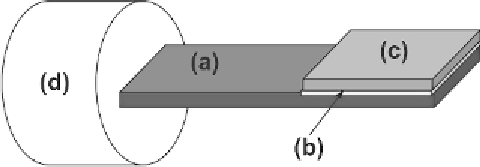Biology Reference
In-Depth Information
immunoglobulin G (IgG), biomarkers, and pathogenic microorganisms
such as
B. anthracis
,
E. coli
O157:H7, and
C. parvum
.
37
This type of mass-
sensitive sensor is a two-layered system with different functions for each
layer (
Fig. 7.8
). The piezoelectric layer, usually made of lead zirconate tita-
nate (PZT), acts as an actuator and a sensor.
38
An alternating current is
passed through the PZT layer. The
n
th resonant mode is obtained at the
frequency
F
n
according to the relation
√
K
/
M
e
where
k
n
= 0.1568, 0.9827, 2.7517, and 5.3923 corresponds to the first four
eigenvalues for a rectangular cross section cantilever,
K
is the effective spring
constant of the composite structure and is a function of the beam thickness,
width, length, and the Young modulus of the cantilever material, and
M
e
is
the effective mass of the cantilever in air.
39
The other layer, which is usu-
ally made of silica or glass, is functionalized with recognition elements to
bind the target microorganism. As in the QCM sensor, mass binding to the
cantilever decreases the resonant frequency. PEMC sensors are extremely
sensitive to mass changes. The mass sensitivity has been determined using
paraffin additions on the cantilever surface and found to be in the range of
0.3-2 fg Hz
−1
.
41
Magnetoelastic (ME) sensors work due to the application of a mag-
netic field that causes them to oscillate.
9
These sensors are fabricated from
amphorous ferromagnetic ribbon, costing only per kilometer, and offer the
possibility of wireless, remote query sensing, thus making them ideal for
incorporation into automated systems. In a time-varying magnetic field,
the ME sensor oscillates with a characteristic frequency that depends upon
F
n
=
k
n
Figure 7.8
Schematic of PEMC-b sensor. (a) The PZT layer, (b) the adhesive layer, (c)
the nonpiezoelectric glass layer, and (d) the nonconductive epoxy used to protect the
electrodes on the encapsulated end of the PZT. For a schematic of PEMC-a, the reader
is referred to Ref.
3
. Source:
Reprinted from Figure 1 with permission from Ref.
40
. Copy-
right (2007) American Chemical Society.



Search WWH ::

Custom Search